An Improved Energy Management Strategy for Hybrid Energy Storage System in Light Rail Vehicles
Abstract
:1. Introduction
2. Onboard HESS Configurations Analysis
3. Energy Management Strategy Design
3.1. Description
3.2. Proposed Sliding Forward Window Strategy in Traction Stage
3.3. Proposed EMS in the Braking Stage
3.4. SC Constraints in Each Traction Stage
3.5. Battery Model and Super Capacitor Model
3.6. The Proposed Cost Function and Constraints
3.7. Simplified Prediction Horizon and Minimization
4. Simulation Results
5. Experimental Results
6. Conclusions
Acknowledgments
Author Contributions
Conflicts of Interest
References
- Lhomme, W.; Delarue, P.; Barrade, P.; Bouscayrol, A. Design and Control of a supercapacitor storage system for traction applications. In Proceedings of the Industry Applications Conference, Kowloon, Hong Kong, China, 2–6 October 2005; pp. 2013–2020. [Google Scholar]
- Barrero, R.; Van Mierlo, J.; Tackoen, X. Energy savings in public transport. IEEE Veh. Technol. Mag. 2008, 3, 26–36. [Google Scholar] [CrossRef]
- Mir, L.; Etxeberria-Otadui, I.; Arenaza, I.P.D.; Sarasola, I.; Nieva, T. A supercapacitor based light rail vehicle: System design and operations modes. In Proceedings of the 2009 IEEE Energy Conversion Congress and Exposition, San Jose, CA, USA, 20–24 September 2009; pp. 1632–1639. [Google Scholar]
- Garcia, P.; Fernandez, L.M.; Garcia, C.A.; Jurado, F. Energy management system of fuel-cell-battery hybrid tramway. IEEE Trans. Ind. Electron. 2010, 57, 4013–4023. [Google Scholar] [CrossRef]
- Torreglosa, J.P.; Garcia, P.; Fernandez, L.M.; Jurado, F. Predictive control for the energy management of a fuel-cell–battery–supercapacitor tramway. IEEE Trans. Ind. Inform. 2013, 10, 276–285. [Google Scholar] [CrossRef]
- Arboleya, P.; Bidaguren, P.; Armendariz, U. Energy is on board: Energy storage and other alternatives in modern light railways. IEEE Electrif. Mag. 2016, 4, 30–41. [Google Scholar] [CrossRef]
- Cheng, L.; Acuna, P.; Wei, S.; Fletcher, J.; Wang, W.; Jiang, J. Fast-Swap Charging: An Improved Operation Mode For Catenary-Free Light Rail Networks. IEEE Trans. Veh. Technol. 2017. [Google Scholar] [CrossRef]
- Tie, S.F.; Tan, C.W. A review of energy sources and energy management system in electric vehicles. Renew. Sustain. Energy Rev. 2013, 20, 82–102. [Google Scholar] [CrossRef]
- Khaligh, A.; Li, Z. Battery, ultracapacitor, fuel cell, and hybrid energy storage systems for electric, hybrid electric, fuel cell, and plug-in hybrid electric vehicles: State of the art. IEEE Trans. Veh. Technol. 2010, 59, 2806–2814. [Google Scholar] [CrossRef]
- Hossain, E.; Perez, R.; Bayindir, R. Implementation of hybrid energy storage systems to compensate microgrid instability in the presence of constant power loads. In Proceedings of the IEEE International Conference on Renewable Energy Research and Applications, San Diego, CA, USA, 5–8 November 2017; pp. 1068–1073. [Google Scholar]
- Herrera, V.I.; Gaztañaga, H.; Milo, A.; Saez-De-Ibarra, A.; Etxeberria-Otadui, I.; Nieva, T. Optimal energy management and sizing of a battery–supercapacitor-based light rail vehicle with a multiobjective approach. IEEE Trans. Ind. Appl. 2016, 52, 3367–3377. [Google Scholar] [CrossRef]
- Amin; Bambang, R.T.; Rohman, A.S.; Dronkers, C.J. Energy management of fuel cell/battery/ supercapacitor hybrid power sources using model predictive control. IEEE Trans. Ind. Inform. 2014, 10, 1992–2002. [Google Scholar]
- Zhao, C.; Yin, H.; Yang, Z.; Ma, C. Equivalent series resistance-based energy loss analysis of a battery semiactive hybrid energy storage system. IEEE Trans. Energy Convers. 2015, 30, 1081–1091. [Google Scholar] [CrossRef]
- Tani, A.; Camara, M.B.; Dakyo, B. Energy management based on frequency approach for hybrid electric vehicle applications: Fuel-cell/lithium-battery and ultracapacitors. IEEE Trans. Veh. Technol. 2012, 61, 3375–3386. [Google Scholar] [CrossRef]
- Lu, S.; Corzine, K.A.; Ferdowsi, M. A new battery/ultracapacitor energy storage system design and its motor drive integration for hybrid electric vehicles. IEEE Trans. Veh. Technol. 2007, 56, 1516–1523. [Google Scholar] [CrossRef]
- Amjadi, Z.; Williamson, S.S. Modeling, simulation, and control of an advanced luo converter for plug-in hybrid electric vehicle energy-storage system. IEEE Trans. Veh. Technol. 2011, 60, 64–75. [Google Scholar] [CrossRef]
- Wang, L.; Collins, E.G.; Li, H. Optimal design and real-time control for energy management in electric vehicles. IEEE Trans. Veh. Technol. 2011, 60, 1419–1429. [Google Scholar] [CrossRef]
- Qu, X.; Wang, Q.; Yu, Y.B. Power demand analysis and performance estimation for active-combination energy storage system used in hybrid electric vehicles. IEEE Trans. Veh. Technol. 2014, 63, 3128–3136. [Google Scholar]
- Saenger, P.; Devillers, N.; Deschinkel, K.; Pera, M.C.; Couturier, R.; Gustin, F. Optimization of electrical energy storage system sizing for an accurate energy management in an aircraft. IEEE Trans. Veh. Technol. 2017, 66, 5572–5583. [Google Scholar] [CrossRef]
- Xiang, C.; Wang, Y.; Hu, S.; Wang, W. A new topology and control strategy for a hybrid battery-ultracapacitor energy storage system. Energies 2014, 7, 2874–2896. [Google Scholar] [CrossRef]
- Carter, R.; Cruden, A.; Hall, P.J. Optimizing for efficiency or battery life in a battery/supercapacitor electric vehicle. IEEE Trans. Veh. Technol. 2012, 61, 1526–1533. [Google Scholar] [CrossRef]
- Song, Z.; Hofmann, H.; Li, J.; Hou, J.; Han, X.; Ouyang, M. Energy management strategies comparison for electric vehicles with hybrid energy storage system. Appl. Energy 2014, 134, 321–331. [Google Scholar] [CrossRef]
- Trovao, J.P.; Pereirinha, P.G.; Jorge, H.M.; Antunes, C.H. A multi-level energy management system for multi-source electric vehicles—An integrated rule-based meta-heuristic approach. Appl. Energy 2013, 105, 304–318. [Google Scholar] [CrossRef]
- Choi, M.E.; Lee, J.S.; Seo, S.W. Real-time optimization for power management systems of a battery/ supercapacitor hybrid energy storage system in electric vehicles. IEEE Trans. Veh. Technol. 2014, 63, 3600–3611. [Google Scholar] [CrossRef]
- Greenwell, W.; Vahidi, A. Predictive control of voltage and current in a fuel cell–ultracapacitor hybrid. IEEE Trans. Ind. Electron. 2010, 57, 1954–1963. [Google Scholar] [CrossRef]
- Herrera, V.; Milo, A.; Gaztañaga, H.; Etxeberria-Otadui, I.; Villarreal, I.; Camblong, H. Adaptive energy management strategy and optimal sizing applied on a battery-supercapacitor based tramway. Appl. Energy 2016, 169, 831–845. [Google Scholar] [CrossRef]
- Li, Q.; Chen, W.; Liu, Z.; Li, M.; Ma, L. Development of energy management system based on a power sharing strategy for a fuel cell-battery-supercapacitor hybrid tramway. J. Power Sources 2015, 279, 267–280. [Google Scholar] [CrossRef]
- Laldin, O.; Moshirvaziri, M.; Trescases, O. Predictive algorithm for optimizing power flow in hybrid ultracapacitor/battery storage systems for light electric vehicles. IEEE Trans. Power Electron. 2013, 28, 3882–3895. [Google Scholar] [CrossRef]
- Pay, S.; Baghzouz, Y. Effectiveness of battery-supercapacitor combination in electric vehicles. In Proceedings of the Power Tech Conference, Bologna, Italy, 13–17 July 2003. [Google Scholar]
- Dougal, R.A.; Liu, S.; White, R.E. Power and life extension of battery-ultracapacitor hybrids. IEEE Trans. Compon. Packag. Technol. 2002, 25, 120–131. [Google Scholar] [CrossRef]
- Camara, M.B.; Gualous, H.; Gustin, F.; Berthon, A. Design and new control of dc/dc converters to share energy between supercapacitors and batteries in hybrid vehicles. IEEE Trans. Veh. Technol. 2008, 57, 2721–2735. [Google Scholar] [CrossRef]
- Wen, Y.L.; Aziz, M.J.A.; Idris, N.R.N. Modelling of lithium-titanate battery with ambient temperature effect for charger design. IET Power Electron. 2016, 9, 1204–1212. [Google Scholar]
- Liu, S.; Jiang, J.; Shi, W.; Ma, Z.; Guo, H. State of charge and peak power estimation of NCM/Li4Ti5O12 battery using ic curve for rail tractor application. In Proceedings of the 2014 IEEE Conference and Expo Transportation Electrification Asia-Pacific (ITEC Asia-Pacific), Beijing, China, 31 August–3 September 2014. [Google Scholar]
- Liu, S.; Jiang, J.; Shi, W.; Ma, Z.; Wang, L.Y.; Guo, H. Butler–volmer-equation-based electrical model for high-power lithium titanate batteries used in electric vehicles. IEEE Trans. Ind. Electron. 2015, 62, 557–7568. [Google Scholar] [CrossRef]
- Safdarnejad, S.M.; Hedengren, J.D.; Lewis, N.R.; Haseltine, E.L. Initialization strategies for optimization of dynamic systems. Comput. Chem. Eng. 2015, 78, 39–50. [Google Scholar] [CrossRef]
- Karamanakos, P.; Geyer, T.; Manias, S. Direct voltage control of dc–dc boost converters using enumeration-based model predictive control. IEEE Trans. Ind. Electron. 2013, 29, 968–978. [Google Scholar]
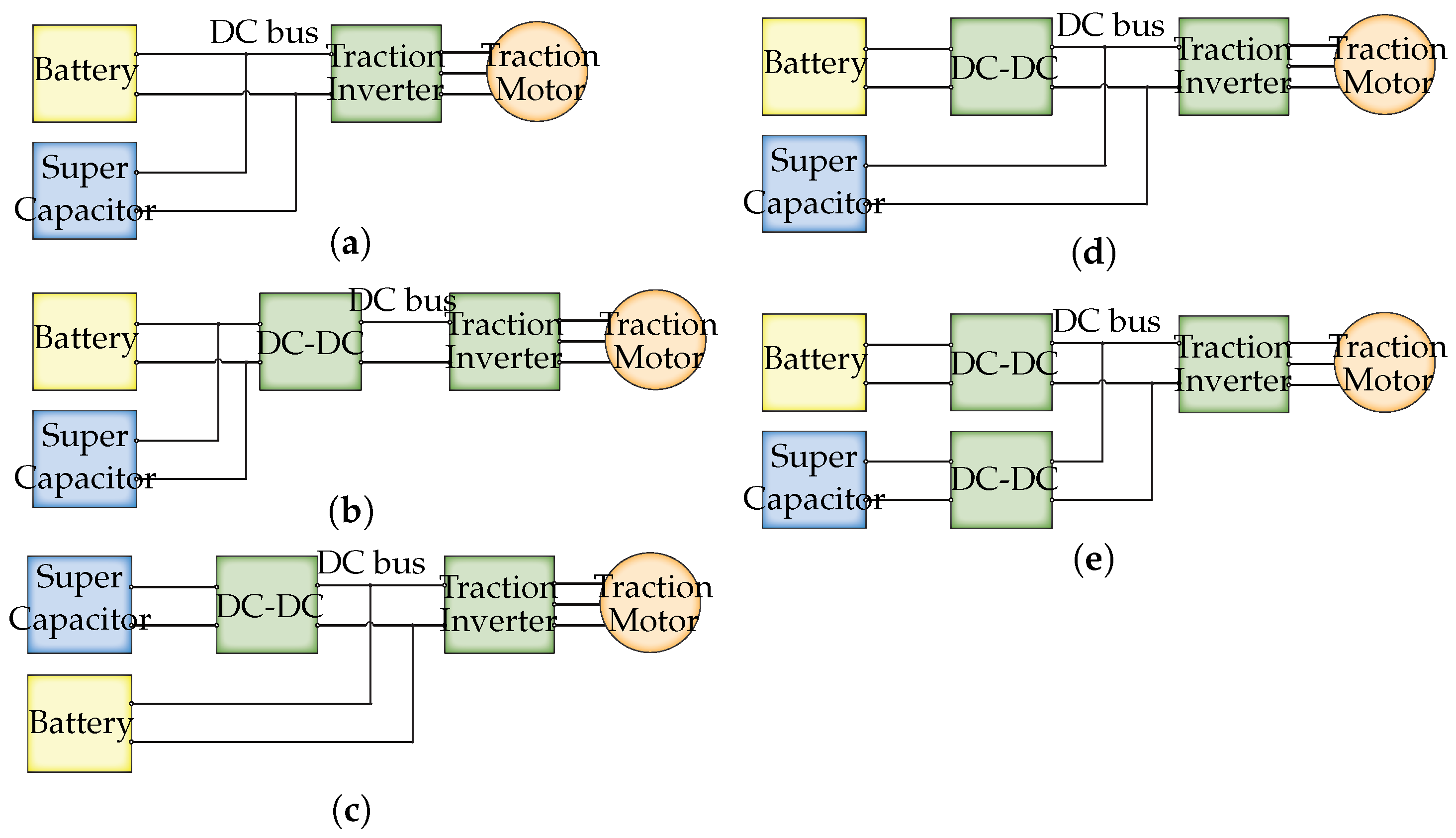
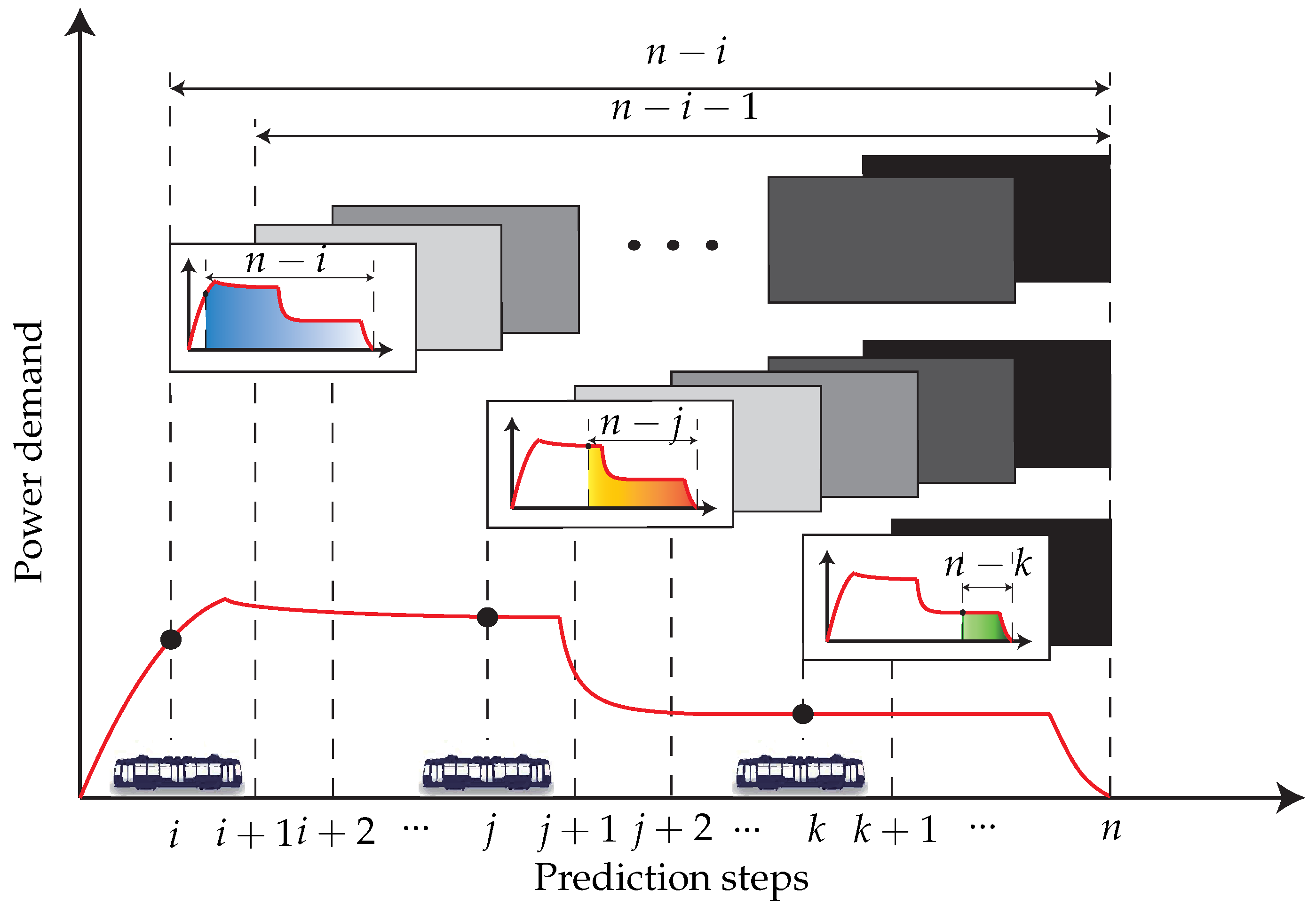

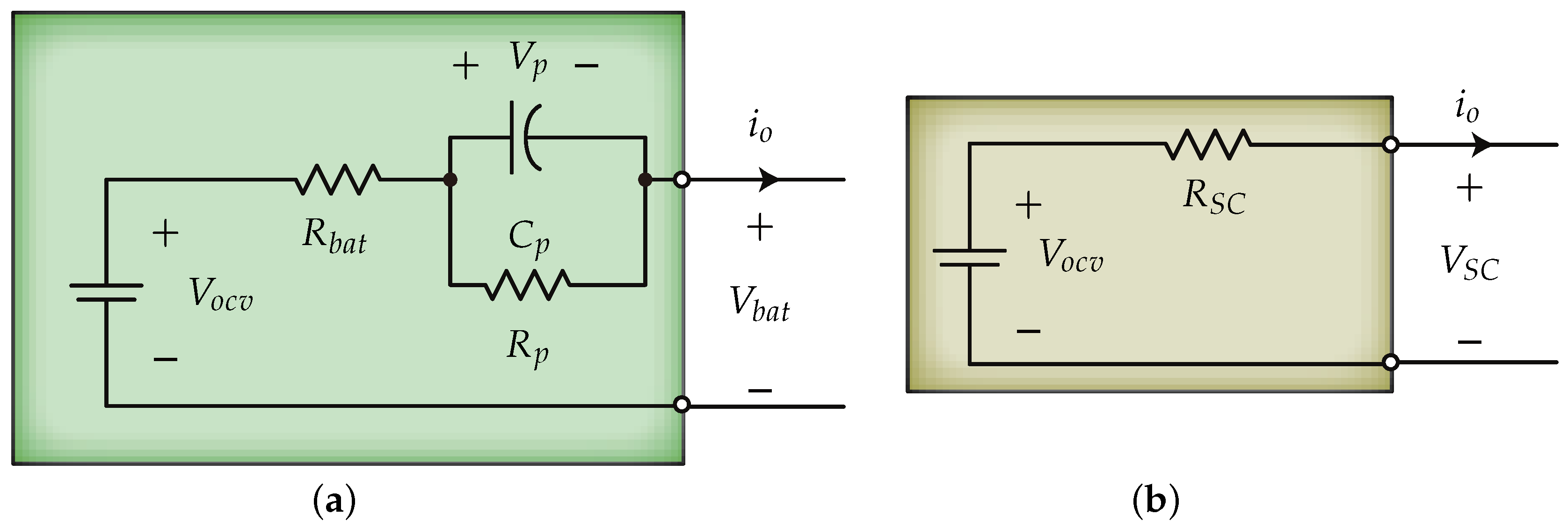
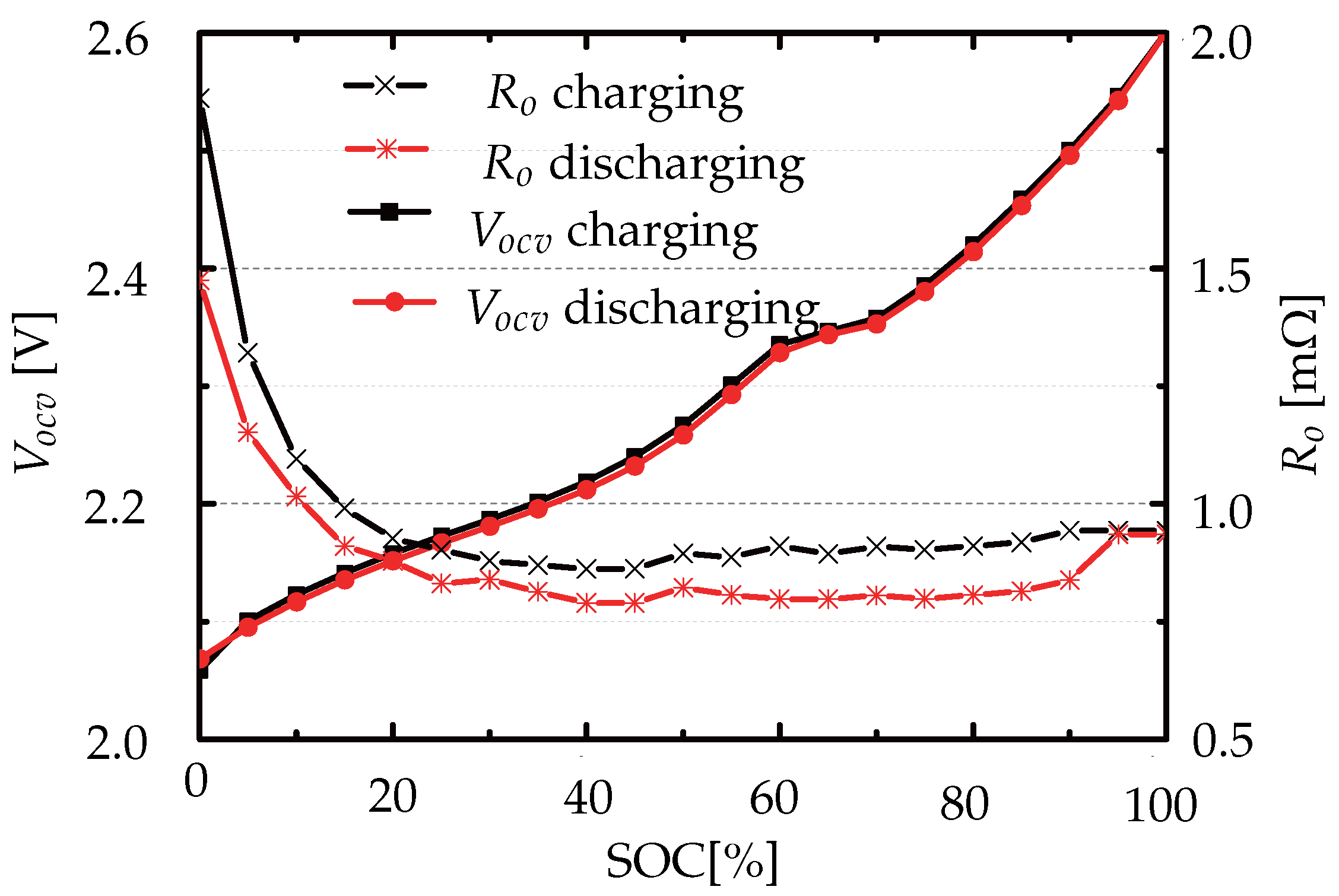



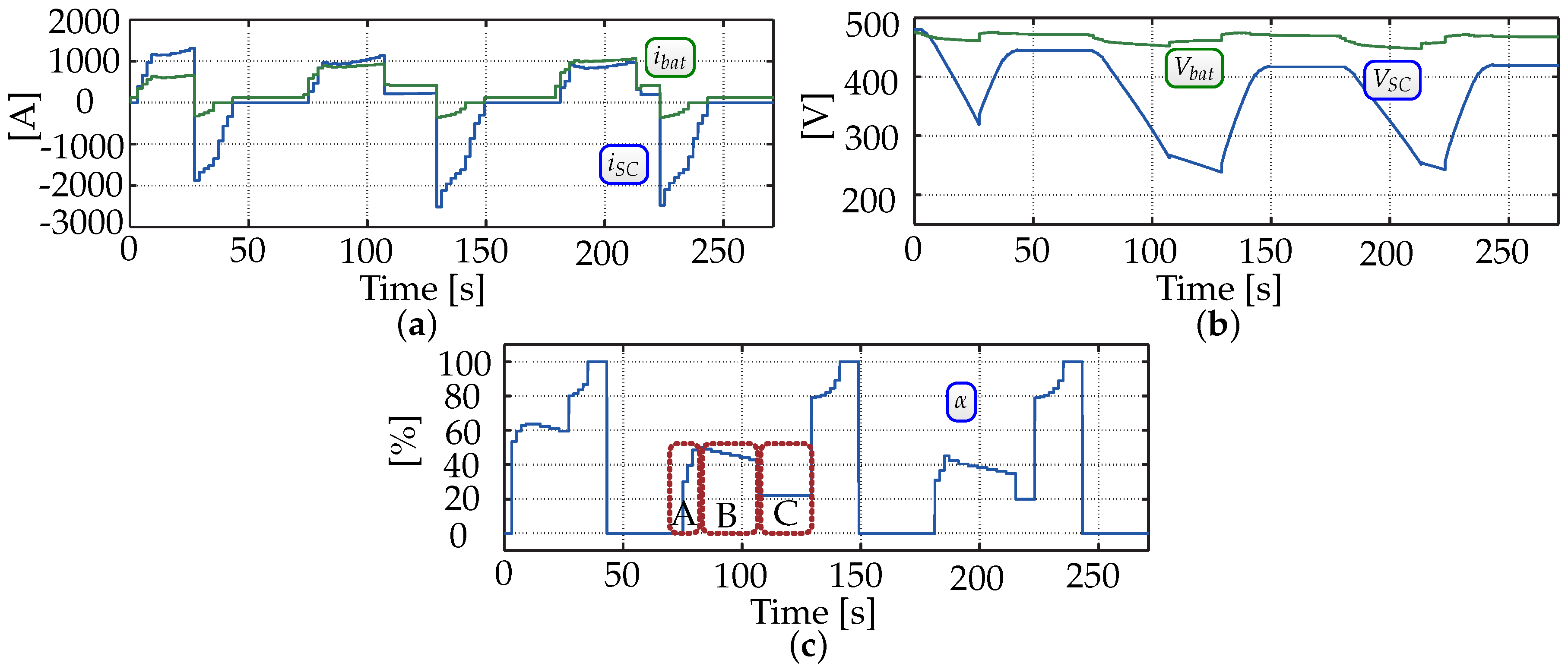
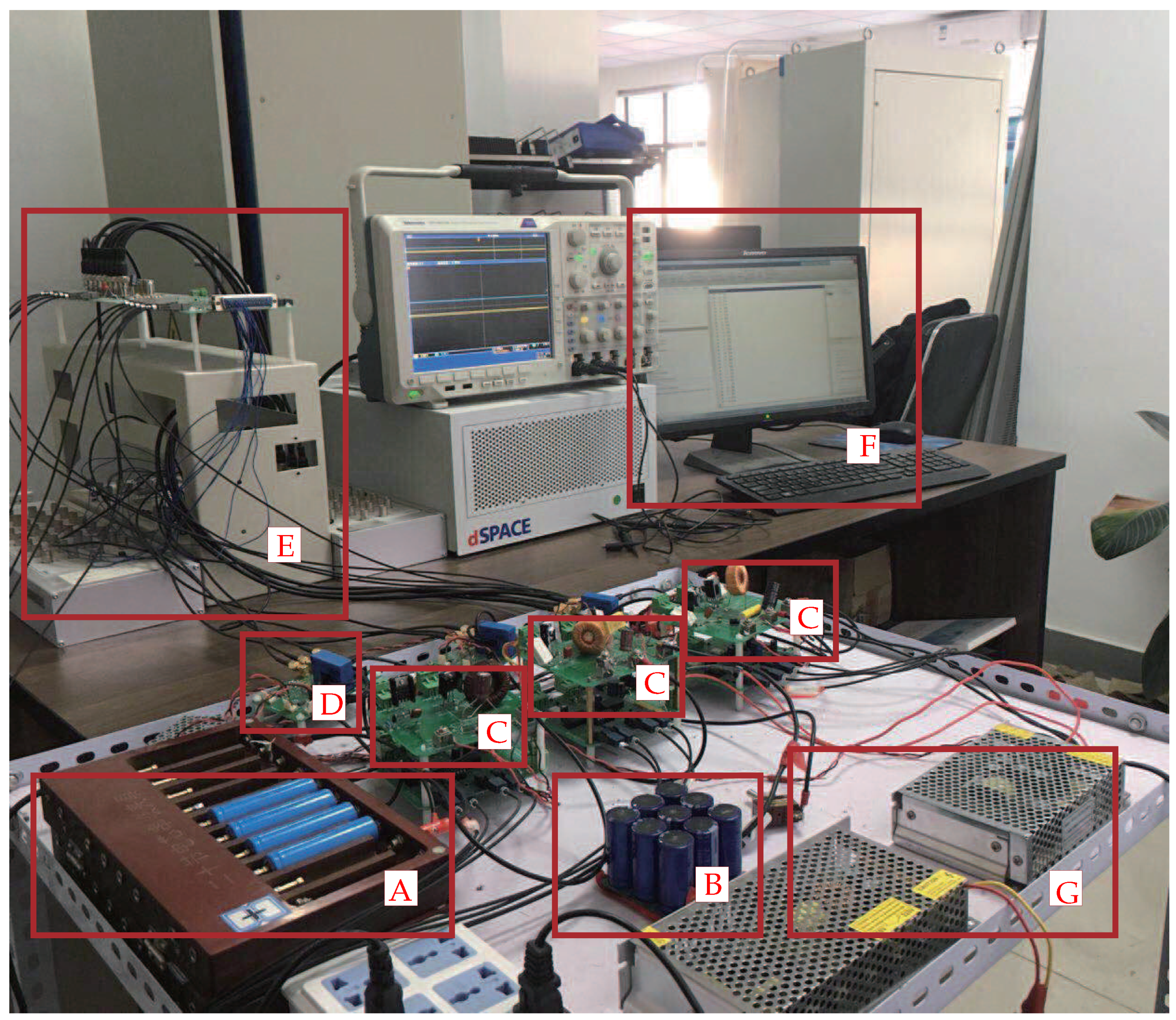
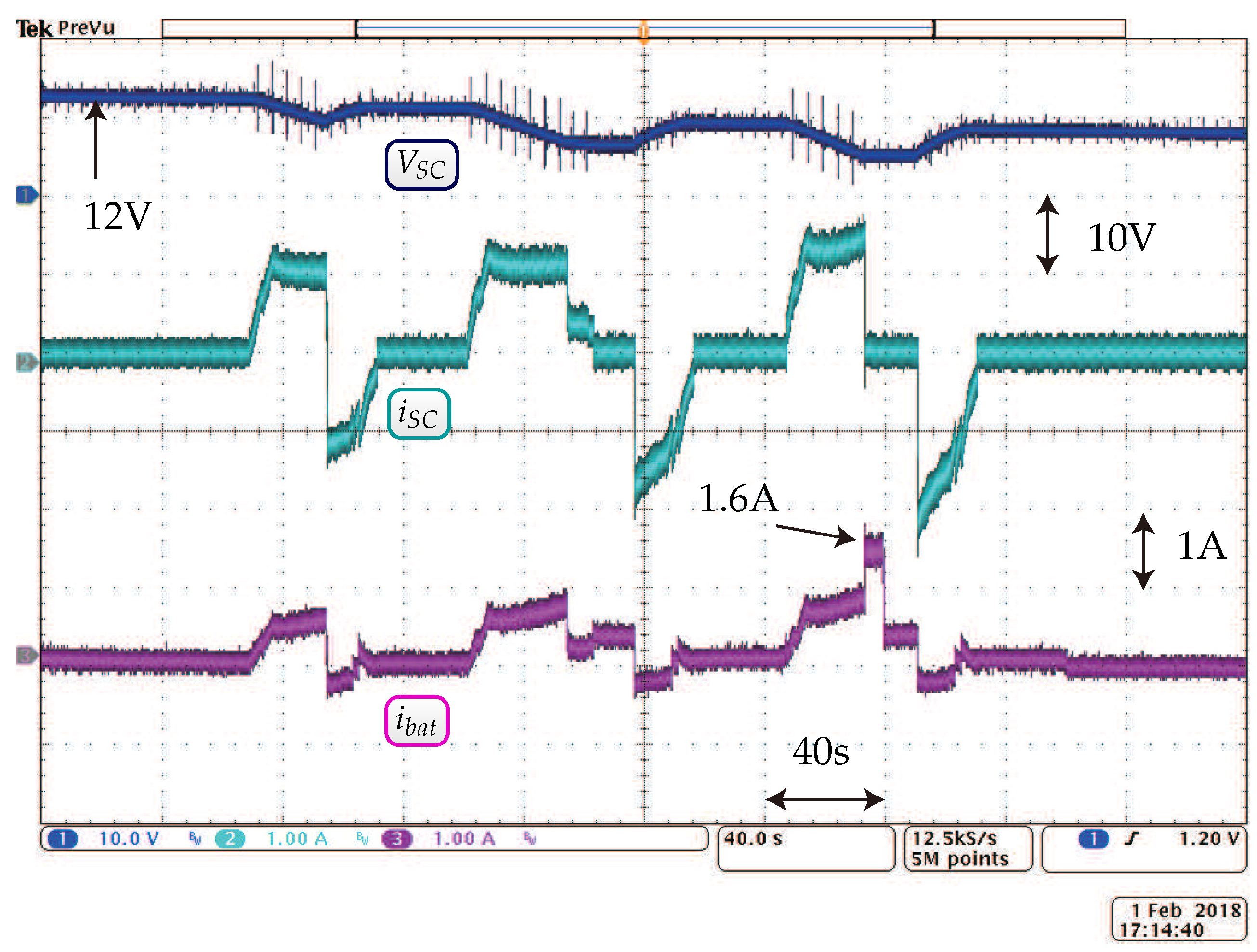
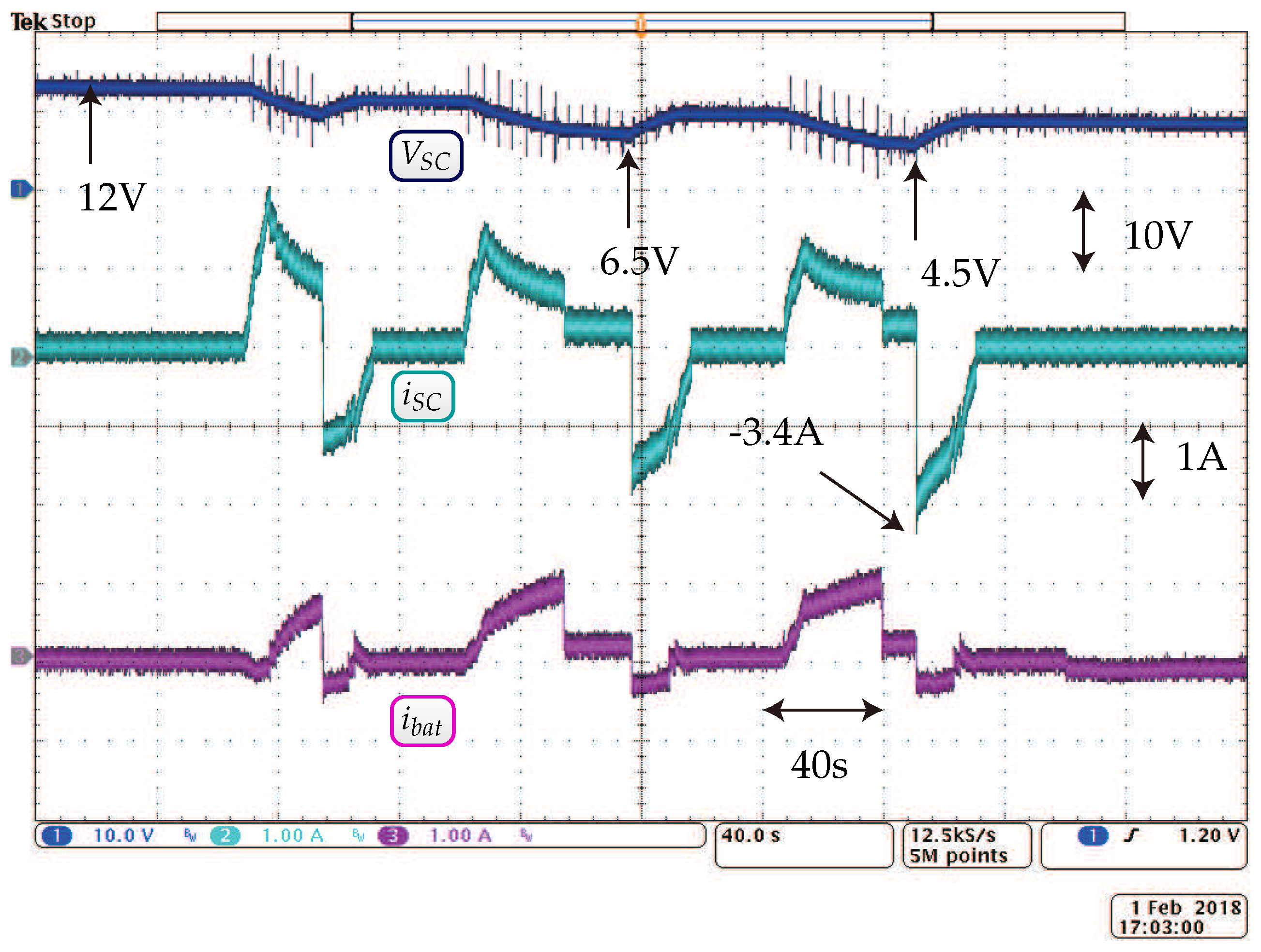

| Parameter | Description | Value |
|---|---|---|
| m | Number of cells in series | 200 |
| n | Number of cells in parallel | 20 |
| C [Ah] | Rated Capacitance | 8.5 |
| [V] | Rated Voltage | 2.3 |
| [A] | Charge/discharge current | 85 (10 C) |
| Parameter | Description | Value |
|---|---|---|
| m | Number of modules in series | 10 |
| n | Number of modules in parallel | 20 |
| C [F] | Rated Capacitance | 83 |
| [V] | Rated Voltage | 48 |
| [A] | Absolute Maximum Current | 1150 |
| [m] | Maximum ESR | 10 |
| Parameter | Description | Value |
|---|---|---|
| Number of battery cells in series | 4 | |
| Number of battery cells in parallel | 1 | |
| [Ah] | Battery cell rated Capacitance | 1.1 |
| [V] | Battery cell rated Voltage | 3.2 |
| Number of supercapacitor (SC) cells in series | 9 | |
| Number of SC cells in parallel | 1 | |
| [F] | SC cell rated Capacitance | 100 |
| [V] | SC cell rated Voltage | 2.7 |
| L [mH] | Inductor of the converters | 450 |
| [mF] | Capacitor of the converters | 220 |
| [KHz] | Switching frequency | 20 |
| [V] | Bus voltage reference | 20 |
| [s] | Optimization step of the power mix | 2 |
| Power demand reduced ratio | 0.000027 |
© 2018 by the authors. Licensee MDPI, Basel, Switzerland. This article is an open access article distributed under the terms and conditions of the Creative Commons Attribution (CC BY) license (http://creativecommons.org/licenses/by/4.0/).
Share and Cite
Cheng, L.; Wang, W.; Wei, S.; Lin, H.; Jia, Z. An Improved Energy Management Strategy for Hybrid Energy Storage System in Light Rail Vehicles. Energies 2018, 11, 423. https://doi.org/10.3390/en11020423
Cheng L, Wang W, Wei S, Lin H, Jia Z. An Improved Energy Management Strategy for Hybrid Energy Storage System in Light Rail Vehicles. Energies. 2018; 11(2):423. https://doi.org/10.3390/en11020423
Chicago/Turabian StyleCheng, Long, Wei Wang, Shaoyuan Wei, Hongtao Lin, and Zhidong Jia. 2018. "An Improved Energy Management Strategy for Hybrid Energy Storage System in Light Rail Vehicles" Energies 11, no. 2: 423. https://doi.org/10.3390/en11020423
APA StyleCheng, L., Wang, W., Wei, S., Lin, H., & Jia, Z. (2018). An Improved Energy Management Strategy for Hybrid Energy Storage System in Light Rail Vehicles. Energies, 11(2), 423. https://doi.org/10.3390/en11020423







